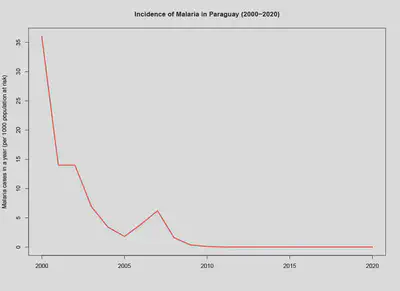2018

Overview
Paraguay was WHO certified malaria-free in 2018 with anti-malaria efforts beginning in the 1950s and continuing up to 2011 when the last indigenous case was reported. During this period, reductions in malaria incidence were accomplished through a strong malaria surveillance system with early detection and investigation of cases in addition to free universal health. Malaria elimination continued after 2011 with the five-year plan to prevent the re-establishment of malaria transmission by strengthening epidemiological surveillance, having robust case management, and organizing public information campaigns on malaria treatment and prevention to promote health-seeking behaviors. Paraguay also partnered with bordering countries of Argentina and Brazil through the Pan American Health Organization (PAHO) and developed an Anopheles mosquito geographic distribution map. A three-year initiative to provide better training for health workers on the malaria front lines was also implemented in 2016. In an effort to sustain its malaria-free status, Paraguay has included its national malaria program within the National Malaria Eradication service as well as organized targeted interventions like passive detection systems and malaria health education in high-risk populations.
Malaria Incidence in Paraguay (2000-2020)
| Year | Incidence of malaria (per 1,000 population at risk) |
|---|---|
| 2000 | 35.760693 |
| 2001 | 13.867354 |
| 2002 | 13.949285 |
| 2003 | 6.864346 |
| 2004 | 3.364033 |
| 2005 | 1.793320 |
| 2006 | 3.866119 |
| 2007 | 6.209972 |
| 2008 | 1.557604 |
| 2009 | 0.360519 |
| 2010 | 0.088917 |
| 2011 | 0.004386 |
| 2012 | 0 |
| 2013 | 0 |
| 2014 | 0 |
| 2015 | 0 |
| 2016 | 0 |
| 2017 | 0 |
| 2018 | 0 |
| 2019 | 0 |
| 2020 | 0 |
References
Lucas, A. M. (2010). Malaria eradication and educational attainment: evidence from Paraguay and Sri Lanka. American Economic Journal: Applied Economics, 2(2), 46-71.
World Health Organization. (2019). Paraguay and Uzbekistan certified as malaria-free. Wkly Epidemol Rec.